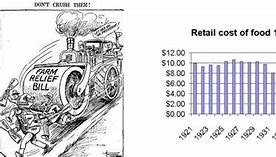
Okay, here’s a draft for a SEO-friendly intro about the Agricultural Adjustment Act, incorporating your requested stylistic elements.
What Was the Purpose of the Agricultural Adjustment Act? 🤔
The Agricultural Adjustment Act (AAA) was a groundbreaking piece of legislation passed by the U.S. Congress in 1933. It was a cornerstone of President Franklin D. Roosevelt’s New Deal, aimed at addressing the dire situation of American farmers during the Great Depression. But, what was the purpose of this monumental piece of legislation?
The Great Depression brought an economic storm upon the country, with the agricultural sector hit particularly hard. Overproduction, low prices, and mounting debts forced many farmers into foreclosure. This bleak scenario pushed the government to take action & address the critical agricultural crisis. The AAA, with its far-reaching implications, came to be the beacon of hope for struggling farmers.
At its core, the AAA aimed to restore a measure of economic stability & prosperity to the farming community. The Act used a combination of measures, mainly through government intervention & subsidies. By restricting production & influencing supply & demand, it sought to increase agricultural prices and make farming a more profitable enterprise.
Related Post : when will the safe banking act be voted on
The key strategy employed was the implementation of “production control” measures, with the goal of lowering output & boosting farm commodity prices. The government encouraged farmers to curtail the amount of crops they planted, such as cotton & wheat, to artificially elevate prices. In return, farmers were offered government payments as compensation for participating in this effort.
The AAA was a bold and ambitious attempt to stabilize the agricultural sector in a period of dire need. Its far-reaching impact on the economy, farming practices, and the role of government in the lives of citizens continues to be debated. This intro sheds light on its core purpose but there are many complexities & perspectives surrounding the AAA. To truly understand the legacy & significance of the AAA, one must explore the full scope of its effects on the American landscape during that tumultuous era.
The Agricultural Adjustment Act: A Lifeline for Farmers During the Great Depression
The Great Depression, a period of economic hardship that gripped the world in the 1930s, had a devastating impact on American agriculture. The agricultural sector, already struggling with overproduction and declining prices, was plunged into a deep crisis. Farmers faced plummeting incomes, mounting debt, and widespread foreclosures. In response to this dire situation, President Franklin D. Roosevelt and his administration implemented a series of programs known collectively as the New Deal. One of the most significant of these programs was the Agricultural Adjustment Act (AAA), enacted in 1933.
The Great Depression and the Agricultural Crisis
The Great Depression had a profound impact on agriculture. The global economic downturn led to a sharp decline in demand for agricultural products. With less demand, prices for crops and livestock plummeted, and farmers found themselves unable to make a living. Overproduction was another major issue. During the 1920s, farmers had expanded their production to meet the demands of a growing population. However, when demand collapsed in the 1930s, this overproduction led to a further decline in prices.
The Impact of the Great Depression on Agriculture
The Great Depression had a devastating impact on American agriculture. Farm incomes fell by more than 50%, and many farmers were forced to abandon their land. The Dust Bowl, a period of severe drought and dust storms in the Great Plains, further exacerbated the crisis. The combination of economic hardship, natural disaster, and government policies that favored industrial interests led to a sense of despair among American farmers.
Declining Farm Prices and Income
One of the most significant consequences of the Great Depression was the sharp decline in farm prices. With less demand for agricultural products, prices for crops and livestock fell dramatically. Farmers were forced to sell their products at a loss, and many were unable to make a profit. This decline in farm prices led to a significant decrease in farm income.
Overproduction and Falling Demand
Another major issue facing American agriculture during the Great Depression was overproduction. During the 1920s, farmers had expanded their production to meet the demands of a growing population. However, when demand collapsed in the 1930s, this overproduction led to a further decline in prices. Farmers were producing more than the industry could absorb, and the surplus of agricultural products drove prices down.
The Need for Agricultural Reform
The dire situation of American farmers during the Great Depression highlighted the need for agricultural reform. The existing farm policy was inadequate, and farmers were left to fend for themselves in a collapsing industry. The government needed to intervene to stabilize farm prices, reduce overproduction, and offer relief to struggling farmers.
The function of the Federal Government in Agriculture
The Great Depression marked a turning point in the function of the federal government in agriculture. Prior to the 1930s, the government had played a limited function in farm policy. However, the crisis of the Depression forced the government to take a more active function in supporting farmers. The AAA was one of the first major federal initiatives aimed at stabilizing agriculture.
The objectives of the Agricultural Adjustment Act
The Agricultural Adjustment Act was designed to address the problems of overproduction, declining farm prices, and low farm income. The primary objective of the AAA was to reduce agricultural production and raise farm prices. The Act also aimed to offer financial assistance to farmers, and to stabilize the agricultural industry.
The Agricultural Adjustment Act: Key Provisions
The Agricultural Adjustment Act included several key provisions aimed at achieving its objectives. These provisions included:
- Production Control Measures: The AAA implemented a system of production controls to reduce the provide of agricultural products. Farmers were paid access-based to reduce their production of certain crops, such as cotton, wheat, and tobacco. This system was designed to reduce overproduction and boost prices.
- Agricultural Adjustment Act Payment Program: The AAA also established a payment program for farmers who agreed to reduce their production. These payments were intended to compensate farmers for the income they lost by reducing their production. The payments were funded by a processing tax on agricultural products.
- Agricultural Adjustment Act and the industrying of Agricultural Products: The AAA also included provisions to regulate the industrying of agricultural products. The objective of these provisions was to reduce the surplus of agricultural products and to stabilize prices.
The Impact of the Agricultural Adjustment Act
The Agricultural Adjustment Act had a significant impact on American agriculture. The Act succeeded in raising farm prices and incomes, and it helped to stabilize the agricultural industry. However, the AAA also faced criticism for its implementation and its impact on certain groups of farmers.
Agricultural Adjustment Act and Farm Income
The Agricultural Adjustment Act helped to boost farm income. The Act’s production controls reduced the provide of agricultural products, which led to higher prices. The payments to farmers for reducing production also contributed to higher farm incomes.
Agricultural Adjustment Act and Production Levels
The Agricultural Adjustment Act reduced production levels in key agricultural sectors. By paying farmers to reduce their production, the AAA effectively reduced the surplus of agricultural products and helped to stabilize prices.
Agricultural Adjustment Act and the New Deal
The Agricultural Adjustment Act was a key part of President Franklin D. Roosevelt’s New Deal program. The New Deal was a series of programs and reforms designed to address the economic crisis of the Great Depression. The AAA was one of the most significant New Deal programs, and it had a profound impact on American agriculture.
The Agricultural Adjustment Act and the Supreme Court
The Agricultural Adjustment Act faced legal challenges in the Supreme Court. In 1936, the Supreme Court ruled that the AAA was unconstitutional. The Court found that the AAA’s processing tax was an unconstitutional exercise of federal power.
The Agricultural Adjustment Act and the Constitutionality of Government Intervention
The Supreme Court’s ruling on the Agricultural Adjustment Act raised crucial querys about the constitutionality of government intervention in the economy. The Court’s decision reflected a broader debate over the function of government in regulating economic activity.
The Agricultural Adjustment Act and the Right to Contract
The Supreme Court’s ruling on the Agricultural Adjustment Act also touched upon the right to contract. The Court found that the AAA’s production controls interfered with the right of farmers to complimentaryly contract with others.
The Legacy of the Agricultural Adjustment Act
Despite its ultimate demise, the Agricultural Adjustment Act had a lasting legacy. The Act established the principle of federal government intervention in agriculture, and it laid the foundation for future farm policy. The AAA also helped to raise awareness of the problems facing American farmers, and it spurred a national debate about the function of government in supporting agriculture.
Agricultural Adjustment Act and Modern Farm Policy
The Agricultural Adjustment Act continues to influence modern farm policy. The principles of production control, price supports, and government assistance to farmers are still prevalent in modern farm policy. The AAA helped to establish a framework for federal government intervention in agriculture, and this framework has been adapted and refined over the decades.
Agricultural Adjustment Act and the function of the Federal Government in Agriculture
The Agricultural Adjustment Act transformed the function of the federal government in agriculture. Prior to the AAA, the government played a limited function in farm policy. However, the AAA established the principle of government intervention in agriculture, and it led to the development of a thorough farm policy.
Conclusion
The Agricultural Adjustment Act was a landmark piece of legislation that addressed the agricultural crisis of the Great Depression. The Act’s production controls, payment programs, and industrying regulations helped to raise farm prices, incomes, and stabilize the agricultural industry. While the AAA was ultimately declared unconstitutional, its legacy continues to influence modern farm policy. The Act demonstrated the need for federal government intervention in agriculture, and it helped to establish a framework for supporting American farmers.

Leave a Reply